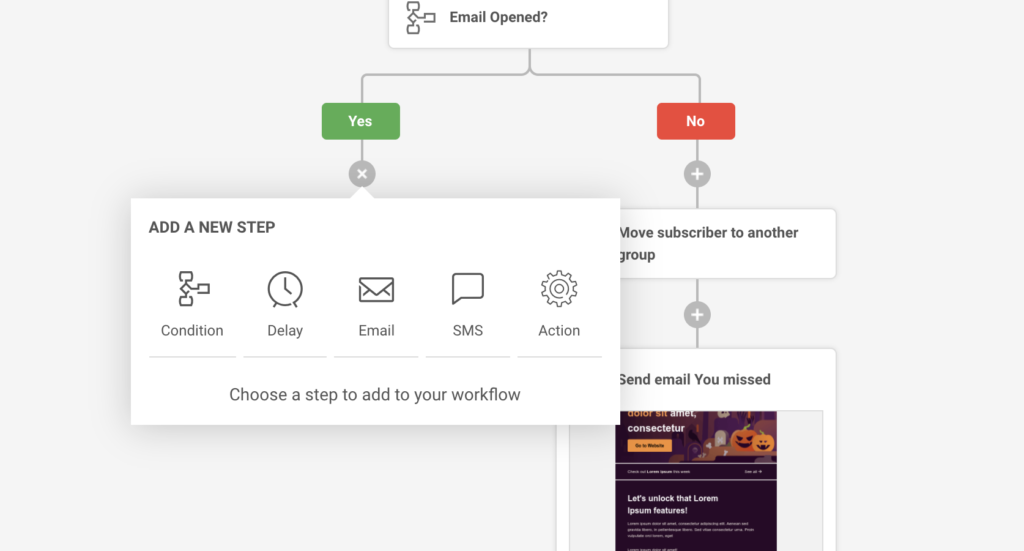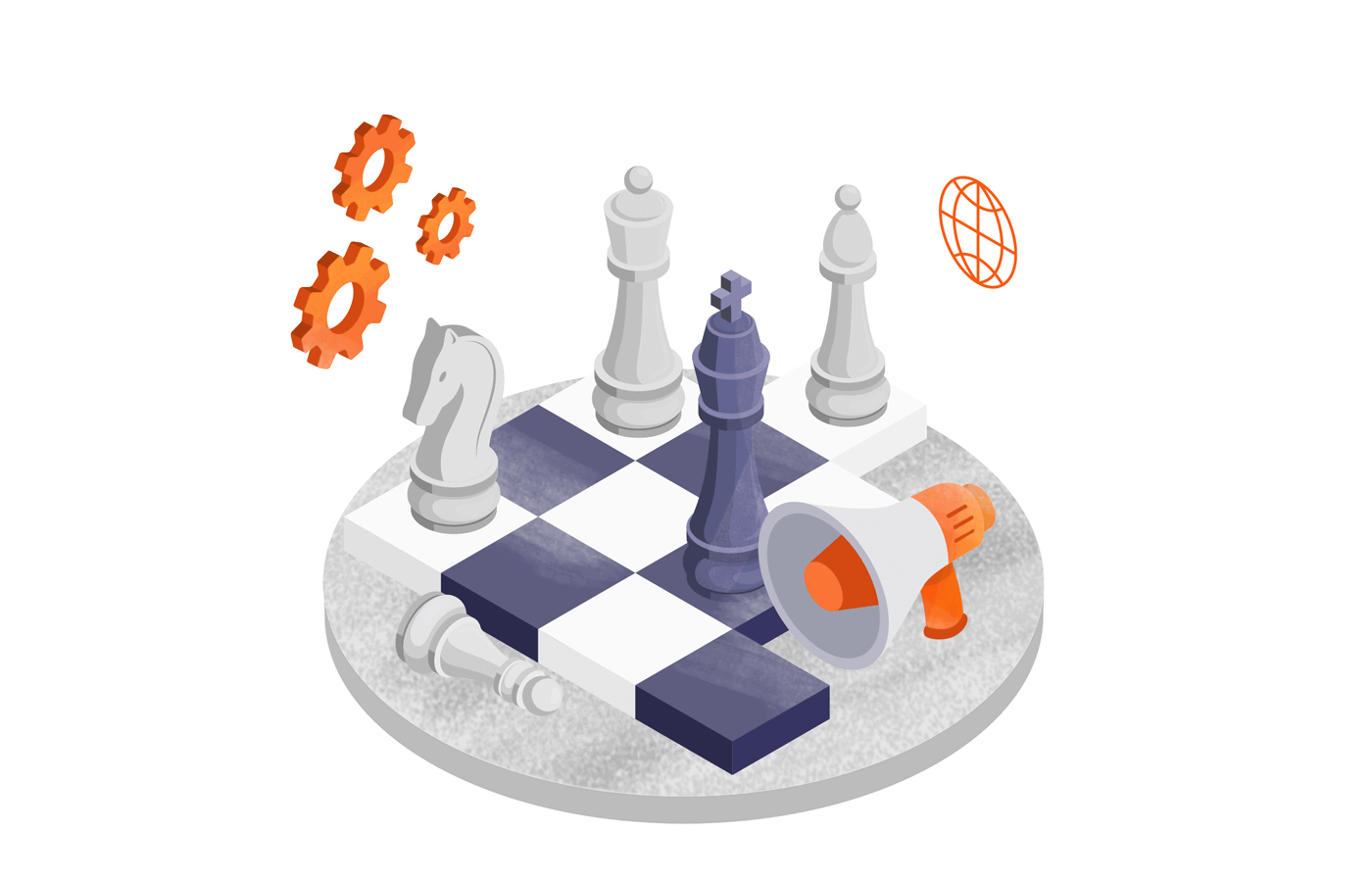Incorporating automation into your marketing strategy is vital for success. A staggering 91% of marketers leverage automation to fulfill their marketing objectives.
By using automated marketing strategies, you can streamline processes, target audiences better, increase productivity, and create more MQLs (Marketing Qualified Leads).
This article will show you how automation can improve your marketing results. You will also learn how to create a killer marketing automation strategy.
Let’s get into it.
What is Marketing Automation?
Marketing automation involves using technology to handle certain aspects of your marketing operations. Instead of manually executing your marketing tasks or workflows, the software does it for you. Marketing automation tools:
- Reduce manual and repetitive tasks;
- Enhance efficiency;
- Improve your targeting;
- Enable better decision-making.
However, automating your marketing efforts does not mean the software will do absolutely everything for you. Depending on the process, you typically need to provide high-level inputs for the automation to work. You can use automation to scale and speed up processes that would be otherwise impossible.
What Can Be Automated?
Almost anything is a fair game for automation in your marketing process. Let’s explore the critical areas of marketing that you can automate:
- Email marketing automation. Automating your email campaigns enables personalized and timely communication with your audience. For instance, you can send automated welcome emails to new subscribers, nurture leads with drip campaigns, send follow-up emails based on user interactions, and much more.
With Sender, automating your email sequences is like a walk in the park!

- Social media marketing and management. You can schedule posts, track engagement, and automate responses. Tools like Hootsuite or Buffer allow you to plan and prepare your social media posts in advance. This ensures a consistent online brand presence.
- SMS/Text messaging. Use SMS automation to trigger welcome messages, alert them of a transaction, send abandoned cart reminders, and more.
- Customer data management. Automate the organization and segmentation of customer data. CRM systems can automate data collection, ensuring you have actionable insights for powerful decision-making. For example, an Airbnb host can send personalized offers based on guest data from previous stays as part of an overall marketing strategy.
- Lead scoring. Automation can make lead scoring easier and faster. Use predictive analytics to score prospects based on historical data.
- Campaign tracking and analytics. View insights on your ad campaigns through automated reporting. See real-time data on user behavior to identify what’s working and what’s not.
The Benefits of Marketing Automation
Embracing marketing automation reshapes how you approach and execute your marketing efforts. 80% of businesses using marketing automation solutions experienced increased lead generation, 77% experienced an increased conversion rate.
Let’s unpack the key benefits of incorporating marketing automation into your playbook:
- Time efficiency: Marketing automation frees your time from manual, time-consuming tasks. Automated processes handle repetitive jobs. This allows you to divide your time into more strategic and creative endeavors;
- Increased customer engagement: Automation ensures your audience receives consistent messaging and attention. As a result, you improve brand awareness and customer engagement;
- Lead nurturing and conversion: Automation helps you to compress your funnel. This means you can move your leads through the marketing funnel faster;
- Data-driven decision-making: Marketing automation tools provide comprehensive data on campaign performance, user behavior, and more. This empowers you to make informed decisions and refine your marketing strategy;
- Improved customer retention: Marketing automation enhances customer retention. It delivers personalized content, timely communication, and targeted offers. It ensures consistent engagement, nurtures customer relationships, and fosters a brand-loyal customer base through strategic, data-driven interactions;
- Scalability: Marketing automation enables scalability and adapts to business growth. Whether you’re a startup or an enterprise, automated processes can handle expanding audiences;
- Cost efficiency: Reduce marketing costs by eliminating the need for extensive manual labor. The long-term savings in time and resources far outweigh the upfront investment;
- Streamlined cross-channel campaigns: Coordinate marketing efforts across many channels. Automation tools enable multichannel synchronization to ensure a cohesive and integrated strategy.
Using marketing automation streamlines processes, which can skyrocket your marketing results.
Creating Marketing Automation Strategies
Now that you understand the concept of marketing automation and its importance, let’s get down to business.
Center your marketing automation strategies around your audience for maximum effectiveness. How so?
Let’s break it down step by step:
Step 1: Understanding Your Buyer Personas
Understanding your buyer personas before implementing automated marketing is crucial. It forms the foundation for a targeted and effective strategy. Buyer personas provide insights into your ideal customer’s demographics, behaviors, motivations, and challenges.
Buyer personas are often thought of as semi-fictional representations of your ideal customers. This approach kind of works if you don’t have any sales data.
The best way to create buyer personas is to look at customers who have already bought your product. Based on this data, you can create personas that have been proven to convert to customers.
Buyer personas are always built based on actual data. If, for some reason, you need to create them from scratch, here’s how you can do that:
- Investigate or research. Do your market research to understand your brand’s target market. That means looking into your current customer base, potential leads, and the industry market trend. In any case, the best way to create buyer personas is from your existing customers. Use them as a model for finding customers with similar characteristics.
- Interview. The purpose of interviewing is to get factual data about your ideal market and customers. You should ask your existing customers and leads:
- Who?– Ask questions that help you understand your audience better. This includes their business size, annual revenue, industry, product offerings, buying behaviors, and preferred sales activities. Knowing who they are will help you tailor your automated ad campaigns and messaging;
- What?– Next, you want to know your buyer’s challenges and pain points. Ask probing questions to gauge how to position your product;
- Why?– This is where you inquire why your brand was chosen or viewed as an option. That will help you know your brand’s unique selling points from your customer’s perspective;
- How?– Now that you have factual information from your sources, ask yourself how you can automate your marketing processes to get leads:
- Problem aware
- Category aware
- Product aware
- Brand aware
- Visualize: Take all your gathered data and visually represent your buyer personas.
Step 2: Choosing Marketing Automation Software
Marketing automation tools are where your marketing workflow and processes get supercharged. When choosing, pick tools based on your automation needs.
Are you looking to automate email, paid ads, social media management, or lead scoring? Remember that you may combine automation tools if one doesn’t suffice.
Here’s how you can choose the right marketing automation software for your business:
- User-friendly interface. Look out for a marketing automation tool with an intuitive interface. Use one that your marketing team can use without unnecessary complexities;
- Personalization features. Ensure the software allows you to tailor your content and interactions based on prospect characteristics and behavior;
- Scalability. You want software that evolves with your business expansion or growth. That’ll help prevent frequent onboarding on different platforms and save you transition costs;
- Integration. Ensure the software pairs well with your existing online marketing tools. It should complement your existing digital marketing campaigns stack without creating isolated silos;
- Analytics and reporting. Analysis is crucial when refining marketing strategy. As such, you want a tool that has analytical and reporting features. Choose one that provides in-depth insights into your marketing efforts;
- Automation capabilities. Assess the automation depth offered by your options. Consider the complexities of your processes and the level of customization you need.
Step 3: Mapping out Your Customer Journey
Your customer journey map represents an individual’s experience and interaction with your business. It’s comprised of buyer personas, touchpoints, and interaction channels.
A customer lifecycle map guides how you identify processes to automate. It helps you understand where and when to incorporate automation at each customer journey stage.
So, how do you create a clear customer journey map for your business?
- Determine the goal: First, review the objective of your journey. Do you want customers to buy? Or do you want them to sign up for your newsletter? This goal will help you determine the frame of your map, including its length and direction.
- Highlight touchpoints: List all your customer touchpoints. You can identify the touchpoints by analyzing the channels customers use to interact with your brand.
- Create an empathy map: Overlay customer emotions at each touchpoint. That will help you understand how customers feel at different customer journey stages. Here’s how to identify customers’ emotions at each touch point:
- Gather data from customer interactions, feedback, surveys, and customer support interactions. Look for clues about their emotions, including negative and positive experiences;
- Categorize customer emotions. Common emotions include joy, frustration, confusion, satisfaction, etc.;
- Associate each emotion with specific touchpoints on the customer journey map. For example, a customer may feel joy when discovering a product but frustration during checkout;
- Relate emotions to your buyer personas. Different segments may have varying emotional responses to the same touchpoint;
- Use a visual format to represent emotions. You can create a chart or diagram with sections for each emotion linked to corresponding touchpoints;
- Identify pain points where customers may feel negative emotions. These are areas that may need improvement in your processes;
- Highlight touchpoints where customers express positive emotions. These are areas where you’re succeeding in providing a good experience.
- Seek direct input through surveys or interviews to validate your empathy map. Customer insights can provide a more accurate understanding of their emotions.
- Create a timeline: Develop a timeline representing the buyer’s journey from initial awareness to post-purchase interactions. This timeline helps visualize the chronological flow of the customer experience;
- Sketch the journey: This is where you connect the touch points and visualize the flow of the customer journey. Create nodes to represent touch points. Link the touch points together and describe how each interaction leads to the next.
Step 4: Deliver Personalized Content
Personalization is crucial in marketing automation campaigns. It helps you show that you know your customer and how to solve their problems.
Delivering personalized and relevant content at each stage of your buyer’s journey impacts:
- Customer retention
- Trust
- Brand awareness
- Faster MQLs
- More conversions
According to Slideshare, 80% of customers prefer to buy from a company offering a tailored experience.
People want to connect with businesses that add value to them. Personalization helps them to experience that. Consider using data gathered from a customer’s interaction with your brand to send relevant content the prospect would be interested in.
Automating your marketing efforts makes personalizing content easier. It leverages data from various sources like:
- Website interactions;
- Social media sites;
- Email engagement;
- Purchase history;
- CRM systems.
This data provides much-needed insights into user behavior, preferences, and demographics.
With such data, you can use automation to serve relevant content to your leads. For example, consider a lead who downloads a white paper about cold email outreach. Based on this, you can send more cold email-related content to this lead.
Step 5: Set up Automated Workflows
Automated workflows are actions or steps automatically executed by software. It can be anything from sending an email to managing customer data.
Follow these steps to set up automated workflows:
- Identify the processes involved in a task;
- Determine what you want to achieve with the workflow and how it fits into your customer journey map;
- Set governing rules or conditions for each task. For instance, a rule can be “send a reminder notification if a customer has an abandoned cart“;
- Implement the workflow using automation software.
An example of workflow automation is welcoming a user after they buy their first product. Based on your defined rules, you can send an email or notification to make customers feel good about their purchase. One way of doing this is by prompting customers to donate to a cause they support.
Implementing these workflows using marketing automation software keeps customers engaged at every stage of their journey.
Step 6: Understanding Your Analytics & Reports
At this point, your automations are nurturing leads while you sleep. But it gets better than that. Leveraging analytics and reporting is where the marketing automation magic happens.
Here’s how to leverage analytics and reports in your marketing automation strategy:
- Identify key metrics: Define the key performance indicators (KPIs) that align with your marketing automation strategy objectives. These may include metrics such as:
- Customer acquisition cost (CAC): CAC is the price tag for acquiring a new customer. It includes all your marketing and sales expenses. It’s the efficiency check for your marketing automation solution, and the goal here is to aim for a lower CAC;
- Click-through rates (CTR): It measures the percentage of people who click on a link. This could be in an email, advertisement, SMS message, or website CTA. The higher the CTR, the more engaging your calls-to-action are;
- Conversion rates: Your conversion rate is the number of people who take the desired action divided by the number of interactions. A higher conversion rate means your lead nurturing game is on point and your marketing automation is effective;
- Unsubscribe rates: This measures the percentage of recipients who opted out of your communications. It measures the relevance and value of your content. While some unsubscribes are natural, a sudden spike may signal targeting or content quality issues;
- Lead conversion time: The average time for a lead to move through the entire funnel from the initial interaction to conversion. It provides insights into the efficiency of your marketing campaign. Shorter conversion times suggest adequate nurturing and quicker decision-making;
- Open rates: This is the percentage of recipients who open your email among all the delivered ones. A low open rate may mean your messages are not being delivered properly.
- Utilize marketing automation platform analytics: Most marketing automation platforms have robust analytics features. Use these tools to gain insights into the effectiveness of your automated workflows. You can easily track the performance of your processes by checking the key metrics in the tool’s analysis and report feature. Then, interpret the data for actionable insights.
- Evaluate customer journey data: Refer to your buyer’s journey map and analyze how customers progress through the stages. You can do that by monitoring customers’ experience at each touchpoint. Identify any bottlenecks or areas where engagement might be dropping off. This analysis will help refine and optimize your automated workflows. In turn, you’ll edge towards a seamless customer experience.
- Segmentation analysis: Take a closer look at how different target audience segments respond to your automated campaigns. Check data like the KPIs listed earlier in each segment to analyze the performance of your marketing process. Adjust your strategies based on the unique preferences of each segment.
- Integration with CRM systems: Leverage CRM and marketing data for a 360-degree view of customer interactions. Sync your marketing data with your CRM for reporting and improved customer insights.
- Continuous improvement: Marketing automation is an iterative process. Regularly review your analytics, learn from the data, and apply those insights to refine your strategies. Continuous improvement is crucial for managing evolving customer expectations and market trends.
Capturing and reporting on your data empowers your marketing team to make informed decisions. They also can optimize campaigns to drive better results. Remember, the goal is to enhance and adapt your automation strategies for long-term success continually.
Automate Your Marketing Strategy with Sender
Elevate the potential of your marketing efforts with Sender. Create high-converting sequences with an easy-to-use interface. Sender empowers your teams to attract, nurture, and convert leads.
From freeing up your time to fostering customer loyalty, Sender is your go-to for increased engagement and efficient lead nurturing. Say goodbye to high costs and hello to streamlined, omnichannel campaigns.
Wrapping Up!
There are many considerations when automating your marketing efforts. You need to know your audience, leverage the right tools, and refine your strategy using analytics.
- Center your marketing automation processes around creating a more personalized nurturing experience;
- When choosing marketing automation software, consider features such as usability, scalability, integration, personalization, reporting, and analytics;
- Ensure you focus on automating processes that will drive the most impact on your marketing efforts;
- Leverage analytics and reporting to iterate and improve how your marketing automation works. This information can also be used to make better, informed decisions for how to improve your marketing strategy.
Also read:
- 17 Top Email Automation Software to Grow Your Business
- What is Data-Driven Marketing? Benefits & Examples
- Email Marketing for SaaS: 15 Strategies to Follow in 2025
Author Bio
Julian Lankstead is the founder of JulianLankstead.com. He helps businesses increase revenue by providing strategies to improve business process efficiency.

